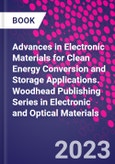Advances in Electronic Materials for Clean Energy Conversion and Storage Applications reviews green synthesis and fabrication techniques of various electronic materials and their derivatives for applications in photovoltaics. The book investigates recent advances, progress and issues of photovoltaic-based research, including organic, hybrid, dye-sensitized, polymer, and quantum dot-based solar cells. There is a focus on applications for clean energy and storage in the book. Clean energy is defined as energy derived from renewable resources or zero-emission sources and natural processes that are regenerative and sustainable resources such as biomass, geothermal energy, hydropower, solar and wind energy.
Materials discussed include nanomaterials, nanocomposites, polymers, and polymer-composites. Advances in clean energy conversion and energy storage devices are also reviewed thoroughly based on recent research and developments such as supercapacitors, batteries etc. Reliable methods to characterize and analyze these materials systems and devices are emphasized throughout the book. Important information on synthesis and analytical chemistry of these important systems are reviewed, but also material science methods to investigate optical properties of carbon-nanomaterials, metal oxide nanomaterials and their nanocomposites.
Please Note: This is an On Demand product, delivery may take up to 11 working days after payment has been received.
Table of Contents
Part I: Advanced electronic materials for solar energy applications1. Introduction to advanced electronic materials for solar energy applications
2. Advanced electronic materials for engineering energy applications
3. Carbon-based nanomaterials for solar energy
4. Quantum dots/Nanoparticles for solar energy
5. Organic semiconducting materials for solar energy
6. Small molecule organic solar cells
7. Polymer Organic Solar Cells
8. Metal halide hybrid perovskite materials for solar energy
9. Metal-halide perovskite nanomaterials and applications
10. Metal-halide perovskites for hybrid solar cells
11. Photon-downconversion materials for solar energy
12. Quantum dot as photon-downconversion materials
13. Organic dyes as photon-downconversion materials
14. Polymer-based nanocomposite for solar energy applications
15. Prospects and future perspective of electronic materials for solar cell applications
Part II. Advanced electronic materials for energy storage (supercapacitor and battery) applications
16. Introduction to advanced electronic materials for energy storage applications
17. Advanced electronic materials for engineering energy storage applications
18. Carbon-based nanomaterials for supercapacitor electrode materials
19. Transition metal oxide nanomaterials as electrodes for supercapacitor applications
20. Transition metal oxides as electrode materials
21. Graphene derivative/transition metal oxides nanocomposites as electrode materials
22. Polymers-based nanocomposite as electrode materials for supercapacitor applications
23. Transition metal oxide nanomaterials-based electrodes for battery applications
24. Carbon-based nanomaterials for battery applications
25. Graphene-derivative decorated transition-metal oxide nanocomposites for battery applications
26. Prospects and future perspective of nanomaterials for energy storage applications
Authors
Aftab Aslam Parwaz Khan Assistant Professor, Chemistry Department, Center of Excellence for Advanced Materials Research, King AbdulazizUniversity, Jeddah, Saudi Arabia. Dr. Aftab Aslam Parwaz Khan is presently working as an Assistant Professor in the Center of Excellence for Advanced Materials Research, King Abdulaziz University, Jeddah, Kingdom of Saudi Arabia. He earned his Ph.D. in Chemistry from Aligarh Muslim University, Aligarh, India in 2011. He has authored 3 books, 15 chapters and more than 130 research papers published in journals of international repute. He is also an Editorial Board Member, as well as a reviewer of many reputed international journals. His research encompasses all aspects of nanomaterials, synthesis, and characterization as well as application in chemical sensing, biosensing environmental remediation of pollution, and drug delivery system for mechanistic and interaction studies using a wide range of spectroscopic techniques and thermodynamic parameters. Mohammed Nazim Research Scientist, Division of Energy Technology, Daegu Gyeongbuk Institute of Science and Technology (DGIST), Daegu, Republic of Korea. Dr. Mohammed Nazim is working as a research scientist in the Division of Energy Technology, Daegu Gyeongbuk Institute of Science and Technology (DGIST), Daegu, Republic of Korea to produce clean energy materials. He is an experienced scientist with more than ten years research experience in clean energy technology applications via organic and hybrid solar cells. He has published more than 17 research articles of high quality, 6 chapters and 2 research patents with a high national and international exposure of research in scientific conferences and seminars. He simultaneously worked in various fields of chemistry, chemical engineering, and material science including nanomaterials, energy materials, green energy, and clean technologies. Abdullah M. Asiri Chemistry Department, Center of Excellence for Advanced Materials Research, King Abdulaziz University,
Jeddah, Saudi Arabia. Prof. Abdullah M. Asiri is the Head of the Chemistry Department at King Abdulaziz University since October 2009 and he is the founder and the Director of the Center of Excellence for Advanced Materials Research (CEAMR) since 2010 till date. He is the Professor of Organic Photochemistry. His research interest covers color chemistry, synthesis of novel photochromic and thermochromic systems, synthesis of novel coloring matters and dyeing of textiles, materials chemistry, nanochemistry and nanotechnology, polymers and plastics. A major achievement of Prof. Asiri is the discovery of tribochromic compounds, a class of compounds which change from slightly or colorless to deep colored when subjected to small pressure or when grind. This discovery was introduced to the scientific community as a new terminology published by IUPAC in 2000. This discovery was awarded a patent from European Patent office and from UK patent. He is also a member of the Editorial Board of various journals of international repute. He is the Vice- President of Saudi Chemical Society (Western Province Branch). He holds four USA patents, more than 800 Publications in international journals, seven book chapters, and ten books








